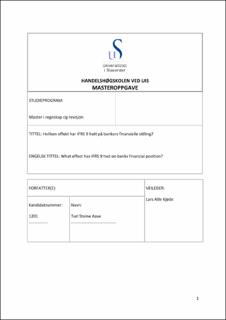| dc.description.abstract | IFRS 9 ble utviklet for å erstatte den tidligere kontroversielle standarden IAS 39. Fra 1. januar 2018 ble det obligatorisk for børsnoterte selskaper å rapportere etter standarden. IFRS 9 introduserer en ny tapsavsetningsmodell hvor ikke bare tap allerede inntruffet skal rapporteres, men også forventede tap. Da bankers balanse i hovedsak består av finansielle instrumenter var det forventet at standarden ville ha en stor innvirkning på deres balanse. I tillegg til IFRS må banker også forholde seg til andre regelverk. Etter Basel III regelverket er det krav om at banker skal ha en ren kjernekapitaldekning på minst 4,5%. Ren kjernekapital, som består av egenkapital vil sannsynligvis reduseres, da egenkapitalen trolig påvirkes negativt av økte tapsavsetninger. Denne studien har undersøkt hvordan tapsavsetning og ren kjernekapitaldekning i norske banker har utviklet seg etter implementering av IFRS 9. Det er hentet inn informasjon om risikovurdering av brutto utlån og tapsavsetning på brutto utlån, i tillegg til rapportert kapitaldekning. Informasjonen er hentet fra bankenes egne årsrapporter. Videre er det foretatt statistisk analyse for å teste om det har skjedd en signifikant endring i tapsavsetninger og ren kapitaldekning, i tillegg til hvordan kapitaldekning har beveget seg i forhold til tapsavsetning. Resultatet viste at det er stor variasjon mellom bankene, og at det gjennomsnittlig ikke har skjedd en signifikant endring i tapsavsetninger. Ren kjernekapitaldekning har da naturlig nok heller ikke blitt signifikant redusert som følge. Det er videre utført en lineær regresjonsanalyse som viser at ren kjernekapital påvirkes av tapsavsetning og at variablene følger hverandre i normalår. Analyse viser videre at endringer i ren kjernekapital er signifikante. Dette tyder på at det er andre faktorer som har påvirket kjernekapital, som for eksempel kapitaldekningsreguleringer innført 31.12.2019. Utviklingen viser at man har kommet nærmere IASBs målsetning med å øke finansiell stabilitet. Ved hjelp av å sette av buffer i normalår oppnår bankene høyere robusthet i usikre tider. Økning i buffer skyldes ikke nødvendigvis IFRS 9. Denne studien finner at endringen i tapsavsetningsprosenten etter innføring av IFRS 9 ikke er signifikant. Studiens funn tyder også på at det fremdeles er mangler i implementering og rapportering, men at det har forbedret seg over tid med mer sammenlignbar informasjon og mindre variasjon. Variasjonene er fremdeles høye, og det er klart rom for forbedringer i fremtidige regnskapsperioder. | |
| dc.description.abstract | IFRS 9 was developed to replace the previous controversial standard IAS 39. From 1. January 2018, it became mandatory for listed companies to report according to IFRS 9. This new standard introduces a new loss provision model where not only losses already incurred must be reported, but also expected losses. As banks’ balance sheets mainly consist of financial instruments, it was expected that the standard would have a major impact on their balance sheets. In addition to IFRS, banks must also comply with other regulations. According to the Basel III regulations, banks are required to have a core capital ratio of at least 4.5%. Core capital, which consists of equity capital, is likely to be reduced, since equity is likely to be negatively affected by increased loss provisions. This study has examined how loss provisions and core capital adequacy in Norwegian banks have developed after the implementation of IFRS 9. Information has been collected on risk assessment of gross lending, loss provisions on gross lending, in addition to reported capital adequacy. The information is collected from the banks’ own annual reports. Furthermore, statistical analysis has been carried out to test whether there has been a significant change in loss provisions and core capital, as well as how core capital has moved in relation to loss provisions. The result showed that there is great variation between the banks, and that on average there has not been a significant change in loss provisions. Core capital coverage has naturally not been significantly reduced as a result either. A linear regression analysis has been carried out, which shows that core capital is affected by loss provisions and that the variables follow each other in normal years. Analysis shows that changes in core capital are significant. This suggests that there are other factors that have affected core capital, such as capital adequacy regulations introduced on 31. December 2019. The development shows that they have come closer to the IASB’s objective of increasing financial stability. By setting aside a buffer in normal years, the banks achieve greater robustness in uncertain times. The increase in the buffer is not necessarily due to IFRS 9. This study finds that the change in the loss provision percentage after the introduction of IFRS 9 is not significant. The study also finds indications that there are still shortcomings in implementation and reporting, but that this has improved over time with more comparable information and less variation. The variations are still high, and there is clearly room for improvement in future accounting periods. | |
